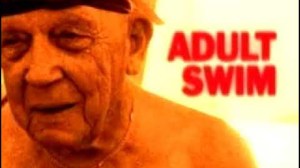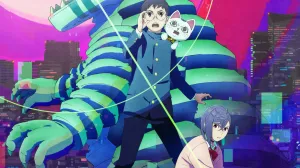
It’s not just the DC Universe that’s getting a facelift today; the world of Scooby-Doo is being reinvented by veteran Justice League creators Keith Giffen, J.M. DeMatteis, and Howard Porter.
Videos by ComicBook.com
In Scooby Apocalypse, familiar faces get a modern update in their look and attitude, and the group not yet known as Mystery, Inc., are facing off against monsters who aren’t wearing masks.
Giffen, DeMatteis, and Porter joined ComicBook.com to talk about the move from Blue Beetle and Booster Gold to Scooby-Doo and Shaggy.
You can pick up Scooby Apocalypse #1 at your local comic shop or on ComiXology today.
How did you guys come to be the team tapped for this project because as soon as I saw your names on it, I’m like, “Wow, that’s probably going to shape up in a real cool way.” But I don’t think if you told me Scooby-Doo that I would have thought, “Oh yeah, let’s get the Justice League 3000 team on it.”
Keith Giffen: Honestly, I really did think that either. I was called out of the blue by Dan DiDio and Jim Lee and asked if I was interested in doing the Scooby-Doo book with [J.M. DeMatteis]. That was one of the things they came in with. They didn’t just offer it to me and I thought of Marc. No, they said, “Same guys from Justice League 3000 and Justice League way back in the fossil age.”
Howard came about simply because I know, I’m sure Marc feels the same way, he’s one of the first names I always mention when I’m doing a book and it’s organic, they call up, if they call me, nine times out of ten, Marc’s going to come in. If Marc and I are involved, 9 times out of 10, Howard’s going to come in. So, it was an offer of a job. Pretty much standard.
J.M. DeMatteis: Yeah, I had no clue. I mean when I heard Scooby-Doo, I kind of went, “What?” It was kind of the last thing you would ever expect. Maybe if Marvel had called with Millie the Model or something I would have said, “What?”
You know, but working with these guys is what’s fun. No matter what the project is, I’m going to have fun working with these two guys. Then, we got down to it and this turned out to be a tremendous amount of fun. We were working on the first issue, I really couldn’t believe what a good time I was having with it and how quickly the characters kind of fell into place and the world, so it’s been great so far.
Howard Porter: Keith called up and said, “Hey, J.M. and I are working on a book,” and I said, “Please, can I do it.” And then I found it was Scooby. [Laughs]
This book, obviously is a big departure from previous Scooby projects that DC had published. Was it a little daunting to kind of take this in a whole other direction? Because when I think of these animated projects, even when they come to comics, they very rarely have the stamp or the style of an artist on them. Typically you get artists who then try to ape the house style of the cartoon.
Porter: Right. Was it daunting? Yeah, it was a little weird. A little difficult in that I have a very definite image in my mind when I think of Scooby, so to translate that into the real world, it took some getting acclimated to that. But it always puts a smile on my face to draw Scooby no matter how grim the situation is so it’s very enjoyable.
With this particular book, you guys talk a little bit about the fact that the monsters aren’t, at least all, fake. Do we get kind of the …
Giffen: None of them are fake. These are monsters, these are real monsters and the whole world has gone to hell in a hand basket. Yeah.
Typically, Mystery Inc. don’t go in assuming they’re going to pull a rubber mask off yet another guy. It seems like they’re there to fight the monster and it just happens that typically it’s not a real monster. So when you were kind of approaching this, was there a difference in the way that you would write these characters in this situation versus how you would write them in a more typical Scooby setting?
Porter: Well, Marc could answer that because he just came off the Scooby-Doo cartoon.
DeMatteis: Right. You know the cool Scooby-Doo is structurally at least, very traditional Scooby. The fun of that cartoon is that they’re sort of bringing in a Monty Python/Woody Allen element to the humor of it. So, it’s very very funny. There’s a lot of … very humor based.
But this is one of our touchstones have been the movie Zombieland where you’ve got a very real horror element happening. It’s not pretend, it’s not fake, there’s nobody under a rubber mask. There’s real horror and the horror plays very very straight. But in the middle of that, you have a group of characters, who I hope are very real, but there’s a lot of humor. A lot of character based humor.
So everything you’ve come to expect from us in our previous work is in here. But it’s not about unmasking the monster. There are mysteries here. There’s definitely mysteries because Scooby-Doo has got mystery but the mystery … there are bigger broader mysteries about how did this happen? What’s going on? Who are the people behind this? So there are a lot of mysteries that the mystery isn’t about pulling out the mask and discovering it was cousin Fred who wanted Daphne’s inheritance or whatever.
So if there’s people behind it at some level, are we going to get eventually a meddling kid reference after all
Giffen: Well maybe not meddling kids, but there are some meddling people. There are people behind it and that will be a slowly unfolding story. Hopefully, not too slowly but for now we’re just focusing on this group of individuals dropped into a world that’s pretty much gone mad. And how they survive, like Marc said, in Zombieland. A group of people who normally wouldn’t be together banded together against seeming insurmountable forces.
DeMatteis: Let me just say quickly, you mentioned like the “meddling kids” references, and we’re dropping little things like that. Shaggy does say, “Zoinks.” There’s a bit in the second or third issue because you know in all the cartoons, Fred’s line is always, “Let’s split up.” So I have Fred say, “Let’s split up” and everyone else goes, “that’s a terrible idea.”
So we’re dropping these little classic Scooby crumbs in here but they play out in a very different context.
Now you touched on something just then with the idea that these are characters that don’t necessarily feel like they would go together in a normal context. Do you think you have to kind of address that? Because in the cartoons and the like, they’re typically kind of archetypes and so they work primarily because you want to have those elements in the story. But when you actually start making it a more character-driven piece and you start looking into who these characters are as people, how does that change things?
Giffen: Ooh, that’s a good question because I don’t know, if the world went to hell around me and everything turned into horrors and monsters except for the four people in the room, I really don’t care who the four people in the room are. If they’re normal, I’m relying on them now.
So, I don’t think it’s a matter of who they like being together more than okay, how do they work together because they’ve been given no choice.
DeMatteis: They’re forced together by circumstance and the first issue really does bring them all individually so you see where Daphne and Fred are coming from. You see where Velma’s coming from. You see where Shaggy’s coming from. They’re all coming from different places and these events force them together. They’re not four old pals that are driving around in their van and stumble upon this. It’s the circumstances of the first issue that bring them together and set them off as a team. Not that they feel they’re a team; they’re just trying to survive.
Was this conceived as something that has a beginning, a middle and an end? Or is this something that you would like to see go on as indefinitely as comics allows in today’s marketplace?
Giffen: It is an ongoing book, so as long as we’re delivering the good and the sales are there, I can see writing this thing for quite a while. I mean, some of the stories, some of the things we’ve dealt with in the first issue, some of the, quote, “mysteries,” unquote, that we’ve introduced will be resolved but I can see myself in on the long haul for this.
DeMatteis: Yeah, we’ve literally got the entire planet has changed without giving away too much. So we’ve got an entire world to explore. By the end of the first issue, they’ve literally, they haven’t even stepped outside yet. They’re dealing with the horrors that are right around them. So they haven’t even fully stepped into that world yet, so there’s a lot to explore.
And with an ongoing series, there’s room for things to change and for the basic structure of the story to change. Who knows what could happen and especially when it’s character based like this. Once you blacken the characters, you’ll follow them wherever they go and hopefully we can follow them for a good long time.
Now do the characters know that it’s the whole world? Because when I think of, like haunted house movie, or even something like The Walking Dead, there’s always that kind of promise, that like, maybe we can find some normal. But when you look at something like Zombieland, which you said you used as a touchstone, there starting point is that they know everything is doomed and they’ve just got to survive.
Giffen: I would say that … Velma knows. Velma definitely knows and I think that the rest of them are being brought up to speed and are gradually dealing with it. So, there is a little bit of an arc of is this really happening, but we’ve got Velma there and she definitely knows it’s worldwide.
Maybe she’s hoping it isn’t at this point. Maybe she’s hoping it’s an isolated incident but as we go along and as they find out more about what happened, it becomes unavoidable. Yeah, it’s worldwide. As for other people who, quote, “survive,” unquote, what the nanites have done, that’s something for the future. That’s something we’ll deal with when the story calls for it.
If you look at Future Quest that came out last week, they’re creating a big shared universe, most of these books are not. But with Scooby, there’s been a lot of other kind characters that have filtered in and out of Scooby’s universe. Even if you’ve look at like Dynomutt and stuff like that. Is that something that, down the road, you’ve got the possibility or the interest in incorporating some other characters into it or do you want to really just focus on this group?
Giffen: I want to focus on the group. Right now I have no interest in any crossovers. I’m not to say that somewhere down the line it might not happen but right now, I’m focused on Scooby-Doo and as far as I’m concerned, the crossovers can wait.
DeMatteis: Yeah, we have to establish these characters, we have to establish this world and we’re getting to know them along with the readers. So if anything else happens with as Keith said, it’s down the line but right now we really are focusing on our core group of characters as they step out into a very very transformed landscape.








